We are happy to share with you some photos of the events we held in December 2023. Our sincerest thanks to all those who participated and making these events very special.
Christmas Lunch at the Hotel Lancelot
Carol singing on the Appia Antica
We are happy to share with you some photos of the events we held in December 2023. Our sincerest thanks to all those who participated and making these events very special.
Christmas Lunch at the Hotel Lancelot

















Carol singing on the Appia Antica


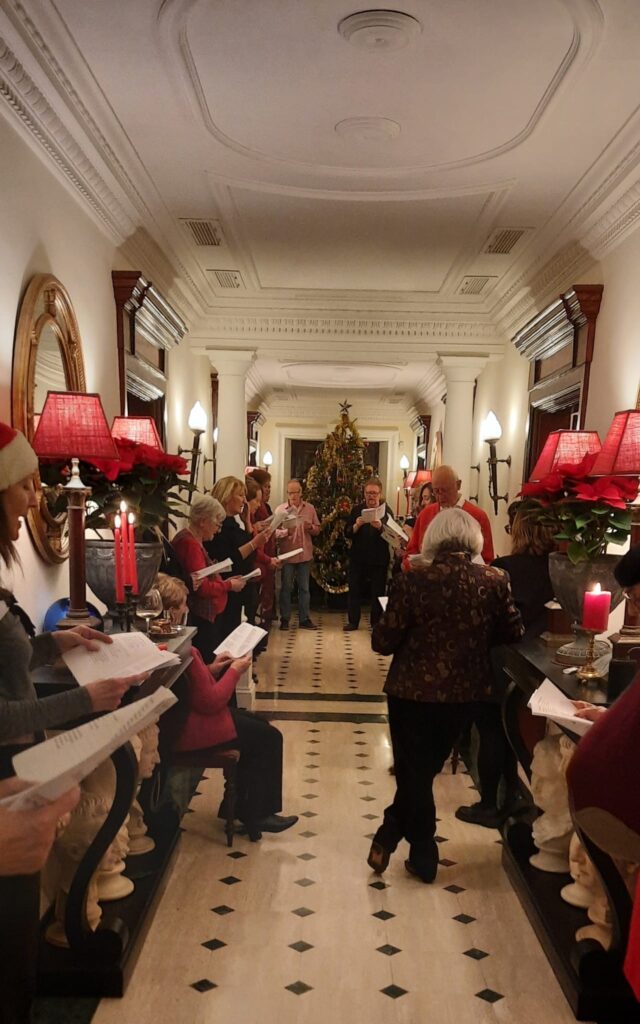








On Saturday 4th November we visited the Marco Carpineti organic winery at Cori, in the Provincia di Latina. Despite the leaden cloud hovering above, the rain held off long enough for us to gaze on the spectacular scenery from the terrace overlooking the vineyards and to admire, in the distance, the white line of the sea.






Our knowledgeable and enthusiastic young guide took us to observe the first stage of vinification: fermentation of the pressed grapes in tall steel cylinders in a refrigerated environment. This led into a remarkable area – artfully built into the living rock – where the wine is stored in oak barrels, barriques and other types of containers
All Carpineti wines are produced in accordance with ecologically sound criteria and traditional methods. Only a small number of ancient local grape varieties, plus selected grapes from other areas in Italy, are used.
Our visit ended with a toothsome lunch, elegantly rustic and prepared with inimitable Italian flair and imagination: vegetable fritters, chickpea soup, a cheese and ham platter and delicious homemade biscuits. Each dish was paired with a superb wine.
This experience that was thoroughly enjoyed by all.








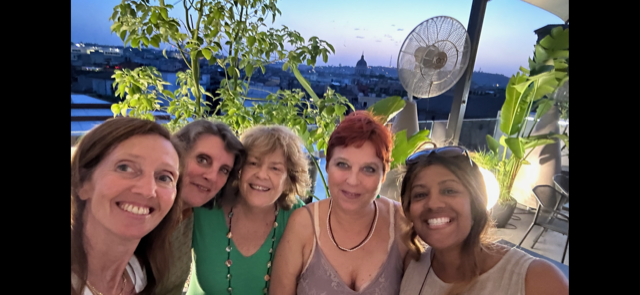




Thank you to everyone that came to our July aperitivo at the Maio Restaurant on the top floor of the Rinascente’s flagship store in Rome’s centre.
On March 4th, members gathered outside the Metro stop of Pigneto, conveniently located in the hub of Pigneto! It was a glorious bright sunny day, and we were eager to learn about the area which was unfamiliar to most of the group!
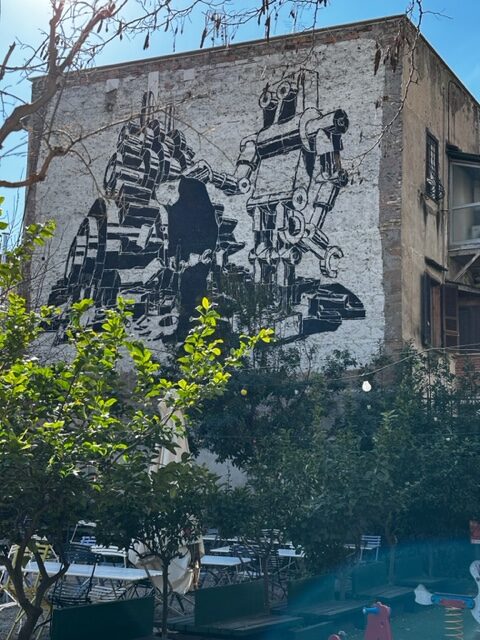




Silvia, our guide, informed us that the neighborhood’s name translates as “the pinewood”, due to the rows of tall pine trees which originally surrounded Villa Serventi, a historical villa in the area. Pigneto’s triangle-shaped perimeter is bordered by Via Prenestina, Via Casilina, and Via dell’Acqua Bullicante. The neighborhood is also subdivided into three sections with squares and roads dedicated to Italian cities, famous commanders, and geographers.
Until the 1870s the area was occupied exclusively by private villas and farmland, in fact, the roads are so narrow we could see that they had been constructed for horses and carts! Walking around we discovered the private colorful villas and beautiful gardens scattered around the neighborhood. We felt like we were already far from Rome!
At the end of the 1800s, today’s area of Pigneto saw the birth of a series of small spontaneous, and unorganized settlements and the subsequent development of different industrial complexes in the 1900s. It became home to a diverse population of industrial workers as many factories were built there. Today it is incredibly diverse and characterized by an interesting architectural inhomogeneity ranging from liberty to baroque to eclectic. It is home to young University students, who ventured away from San Lorenzo, artists, bohemians, and immigrants from across the globe who rub shoulders with Rome’s timeless old-school.
Pigneto was badly bombed during World War II, like nearby San Lorenzo. In fact, the area features in Roberto Rossellini’s film “Roma Città Aperta”, a portrait of a war-torn city.
In the 1960s Pigneto became a hotbed of left-wing activism and counter-culture with the famous writer and director Pier Paolo Pasolini casting the neighbourhood’s longest and most influential shadow. We were introduced to the most famous bar and restaurant in the area “Necci dal 1924”, also a popular hangout of Pasolini’s, who filmed his first film “Accattone” there in 1961. We also unanimously agreed what a perfect location it would be for one of the Association’s aperitif this summer!!


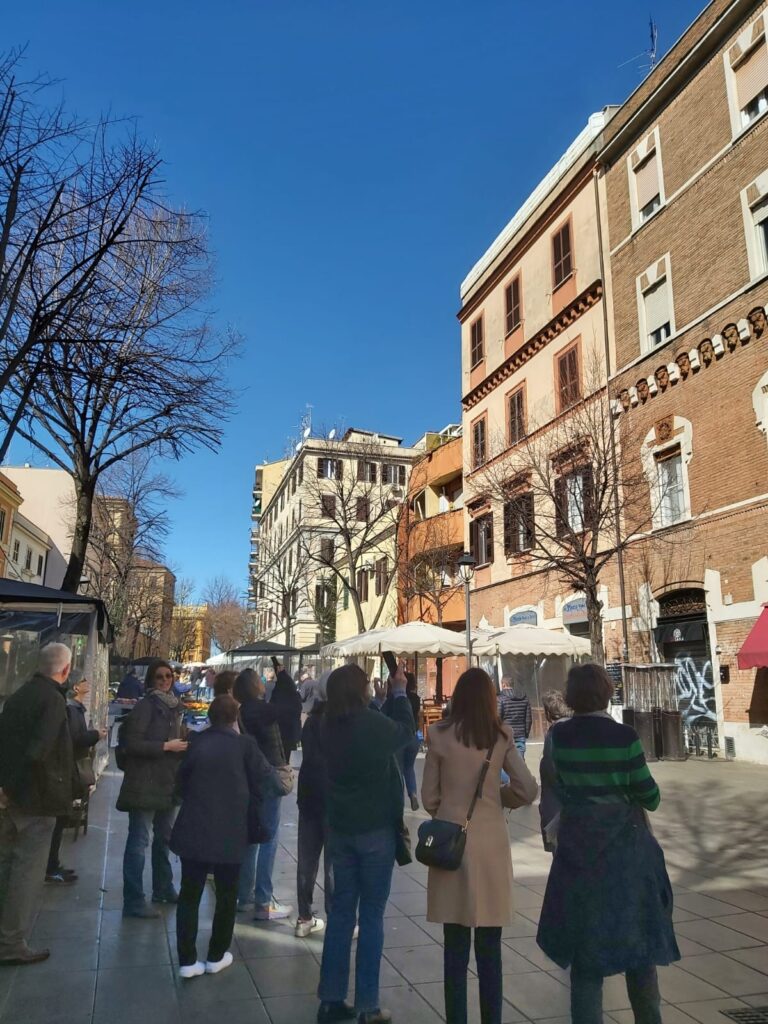


Walking through the alleys and narrow streets, we admired the incredible street art, which colors stood out even more prominently against the intense blue sky! The vibrant murals everywhere spoke vividly of Pigneto’s past, present, and future!
It was a beautiful warm November Sunday morning, as we gathered on the white steps under the stunning Bersagliere monument at Porta Pia. As we waited leisurely for our guide, Silvia, and other attendees to arrive, one couldn’t help ask “Why are the Bersaglieri always running?” With a bit of luck, we might find out!



ThePorta Pia gate was built between 1561 and 1565 within the ancient Aurelian Walls between the Porta Salaria and the Porta Nomentana. Pope Pius IV (1559-65) commissioned plans for the gate and turned to Michelangelo to provide him with 3 designs. Famous for his frugalness, Pope Pius chose the cheapest design which was a far cry from Michelangelo’s more splendid works around the city. The inward facing Porta Pia gate was Michelangelo’s last architectural work as he died shortly before it was completed.
Silvia indicated the rather plain decorative motif on the façade above the coat of arms symbolizing a towel draped over a bowl and a bar of soap, a nod to the Pope’s humble origins, coming from a family of Milanese barbers.
On September 20th, 1870, during the unification of Italy, the troops of the Kingdom of Italy entered the city a few metres west of the Porta Pia gate. The Bersaglieri were sent ahead to scout the ground but on this occasion the army were right behind them, so they had to run to enter first. “Ah OK, now I get it!” This historic moment brought an end to the Papal rule of Rome.


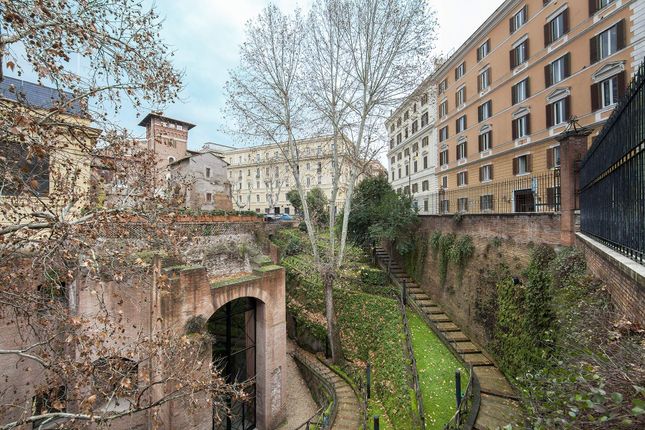
Walking slowly and chatting amicably to each other along the Aurelian wall to the ruins on Via Sulpicio Massimo, Silvia entertained us with the fascinating story of the small boy poet “Quinto Massimo Sulpicio”, who was represented by a very small statute known as the “Cippo”, discovered during the enlargement of the square of Porta Salaria in 1921. His story dates to 94 BC, at 11 years of age, Quinto was already a genius and took part in a Greek poetry contest. Many famous poets competed, but Quinto, who improvised 40 verses, no doubt astonished them all. He finished third among fifty-two competitors, arousing great admiration. Sadly, due to the strenuous mental effort, he subsequently became ill and died a few days after the competition.
The next stop of our tour was the gorgeous Piazza Sallustio, home to the “Horti Sallustiani” (Gardens of Sallust). The Horti were built by the historian, Sallustio Crispo in the 1st century BC, on land that had previously belonged to Caesar. It covered the valleys and scenic slopes of the area. One of the main points of interest was the imposing remains in the middle of Piazza Sallustio; its style recalls the Canopo in Hadrian’s Villa in Tivoli.
The Horti were maintained for several centuries by the Roman Emperors as a public amenity. Over the years, many Emperors chose it as a temporary residence, as an alternative to the official seat on Palatine Hill. When Cardinal Ludovico purchased the site in the 16th century to construct Villa Ludovisi on part of the land, many important and historic sculptures were discovered, including the Obelisco Sallustiano, a Roman copy of an Egyptian obelisk which now stands in front of the Trinita dei Monti church above the Spanish Steps.
We continued our neighbourhood tour admiring the numerous, architecturally rich villini in the area, including where the famous film director Roberto Rossellini lived until he was two. We saw Villino Casata Stampa, home to the eccentric Marquise Luisa Casati Stampa known to have kept cheetahs and peacocks in her garden! We also saw the eclecticism style of the Villino Levi, where the family Levi lived until they were taken and deported to the concentration camp of Auschwitz in 1944


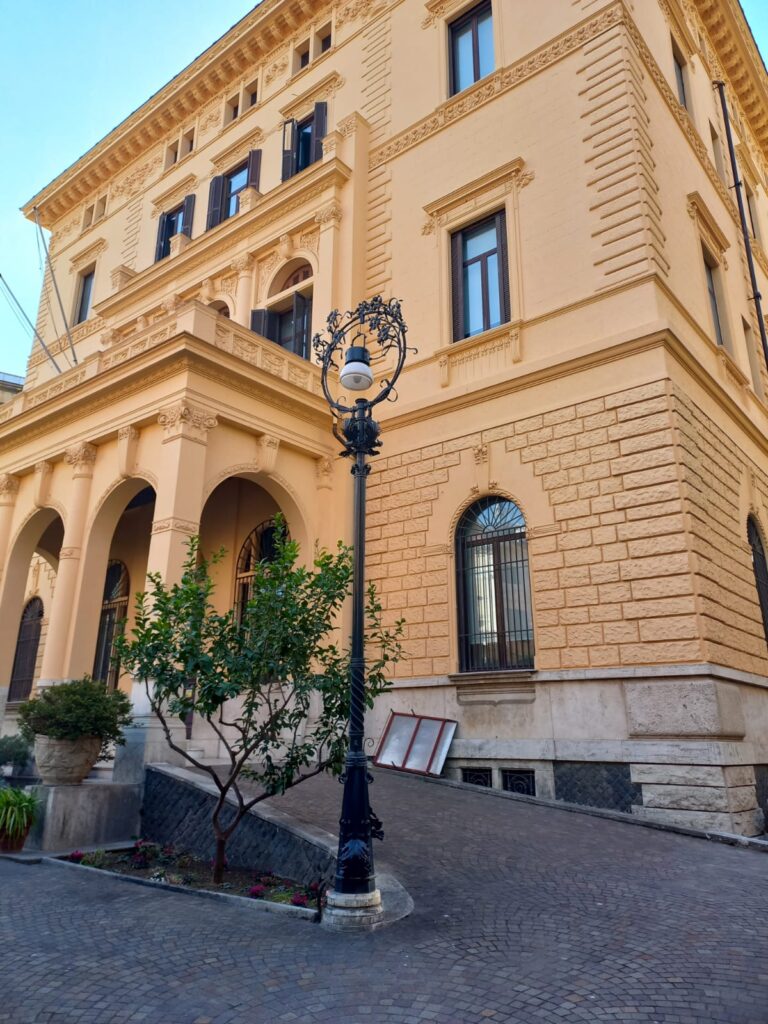
Today, most of the Villini are occupied by banks, and insurance companies, and even “Netflix” has carved a home among the beautiful palazzi.
Our walk continued to the spectacular and grand U.S. Embassy building, once the home of the first Queen of Italy, Queen Margherita. We were shown Queen Margherita’s “local parish church” to whom she had gifted an organ. As we strolled and admired its beauty, music form the very organ filled the street and left us in awe.
Our tour concluded with a sighting of the British Embassy, built by Sir Basil Spence in 1971. As we expressed our discontent in our very own embassy, Silvia laughed and said, “Sir Basil hated it too!”
On her 21st birthday, in a speech given during a tour of South Africa and broadcast by radio from Cape Town, Princess Elizabeth vowed to serve her country and the Commonwealth for the whole of her life. Significantly, perhaps, “God is my oath” is one of the meanings of the name Elizabeth, derived from the ancient Hebrew Elisheba. Little did she realise at that time how soon she was to be called on to succeed her father and honour that vow.

The coronation of Elizabeth II on 2nd June 1953 was a spectacular event, aired by BBC television in black and white. The J.Arthur Rank movie in Technicolor, A Queen is Crowned, was screened at cinemas everywhere and featured a commentary delivered with the crisp diction and vigorously rolled Rs of thespians and BBC announcers of that era.
The dreary British weather on the day did not dampen enthusiasm. In the procession of carriages bearing Commonwealth leaders, one figure in particular stood out: the majestic Queen Salote of Tonga, six feet three inches tall. Undeterred by the rain, she smiled and waved to the cheering crowd.
The entrance of the young Queen into Westminster Abbey, at once regal and modest in her beautiful robes and diadem, was awe-inspiring. As she proceeded gracefully down the aisle, the choir burst into a glorious performance of Handel’s Zadok the Priest. The words of the hymn were a reminder that the coronation was a religious service, firmly rooted in the tradition of anointing the kings of Israel:
Zadok the priest
And Nathan the prophet
Anointed Solomon king
And all the people rejoiced.
Because of its deep religious significance, the solemn anointing with precious oils by the Archbishop of Canterbury took place behind a screen. It was an electrifying moment for the Queen, who said that it transformed her.
Throughout her reign the Queen was widely admired and loved, but she also came in for severe criticism. A scandal erupted in 1957, when John Grigg, the 2nd Baron Altrincham, a liberal Conservative peer and author, wrote an article attacking the content of the Queen’s speeches and her manner of delivery. He blamed the members of the Court, who came from the British upper classes and in his view did not reflect society.
Lord Altrincham’s comments caused shock waves, though he insisted that they were intended as constructive advice. In order to ensure its survival, the monarchy had to keep pace with the changing twentieth century. “The boss”, in his words, needed to know what was wrong and put it right.
It would appear that Mr Grigg’s opinions did not go unheeded. One noticeable change was in the Queen’s speeches. The traditional rhetoric composed by the monarch’s speech writers gave way to a livelier and more modern style. Over time, the Queen’s very refined royal pronunciation became softer and more relaxed. A very shy person, she now allowed herself to be less reserved, frequently revealing a dry sense of humour, yet never losing her flawless composure and grace. She stopped using her trademark “My husband and I”.
The Queen had an explanation for those who accused her of being stiff and unsmiling. At times she was so moved by the people’s manifestations of support and kindness that she had to exert iron self-control to hold back the tears. Also, the look sometimes caught on camera and mistaken for sovereign displeasure was in fact nothing of the kind. It was simply the expression that anyone can have in unguarded moments when the features are in repose. With characteristic wit, she called this her “Miss Piggy face.”
As a constitutional monarch, she had to be rigorously impartial, but on one occasion felt compelled to issue a statement deploring cheque-book journalism. This happened in the wake of the thirteen horrendous murders committed by serial killer Peter Sutton between 1975 and 1981.
After the death of Diana, Princess of Wales, the Queen was persuaded by Prime Minister Tony Blair to come to London and speak to her people. Only days before, baying crowds had demanded the Queen’s immediate return from Balmoral. The mood was ugly. It was a watershed moment, when the monarchy was at risk as never before. The Queen’s address “as a grandmother and as your Queen” to the crowd from Buckingham Palace and the tribute she paid to Diana had a calming effect on the volatile situation and immediately re-established the authority of the monarchy. Such was her almost earth-mother charisma. Her authority and compassion as Queen and matriarch were validated on other occasions, notably after 9/11 and during the Covid-19 pandemic.
For those of my generation, the Queen was part of our lives and a steadfast, constant presence since we were very young. We witnessed her evolution from a beautiful, fun-loving young woman into a superb head of state, and then the twinkly-eyed but feisty great-grandmother who was easily persuaded to take part in a sketch with James Bond. Many outstanding actors have interpreted her on screen. But nobody can ride side-saddle like the Queen. They have all accentuated a certain haughty primness, rather than her warmth and kindness. Her essence has eluded them.
Her parting gifts to us were a wonderful Platinum Jubilee and a hilarious, yet bittersweet, spoof with Paddington Bear. True to form, after the fireworks had gone out, she retired without fuss to her beloved Balmoral, where her brief candle flickered out humbly, quietly and discreetly.
Posted by Association member Julie Dixon
This remarkable exhibition of the famous sculptural group depicting Orpheus and the Sirens is currently being held until October 18th at the newly created Museum of Rescued Art. The statues will then be returned to Taranto, where they were first discovered.
The three figures, originally in vivid polychrome terracotta, date back to the latter half of 4 BC, during the colonisation of Magna Graecia. Over the centuries the paint has faded to a subtle shade of warm rosy beige. The craftsmanship is astonishing: each sculpture is marvellously and realistically carved with a refinement and expressivity usually associated with marble. They are thought to be part of a funerary monument in which the statue of Orpheus probably represented the owner of the tomb.




In Greek mythology a Siren is a creature that is half woman and half a kind of weird wader bird with claws who lures sailors to their death by the irresistible power of her singing. Sirens also accompany the souls of the dead to the underworld and comfort them with their soothing melodies. The idea of the mermaid, half fish and half woman, took shape centuries later in the medieval imagination and may be the result of a mistranslation.
The scene portrayed in the group is from the tale of Jason and the Argonauts, who were searching for the Golden Fleece. On the ship with them is Orpheus, a sort of demigod, and a renowned poet and musician. Whenever he plays his lyre, the sound is so exquisite that the birds fly to him and form a halo over his head. The divine strains entrance the sailors and disempower the Sirens, who are so distressed that they commit suicide by flinging themselves into the sea.
Later, Odysseus sails by. He is an intellectual with an insatiable thirst for knowledge and experience (rather too much, according to Dante, who puts him amongst the evil tricksters in the eighth circle of Hell) and is determined to hear the seductive songs. He makes the sailors plug their ears with beeswax, so that they cannot be bewitched by the Sirens; and he has himself bound to the mast to prevent the ship from veering off course and dragging him and the crew down to the underworld. Instead of being repelled by the Sirens and their ugly claws, Odysseus sees only the dazzling beauty of Helen of Troy in their faces.
In line with Pythagorean philosophy, Orpheus and the power of his music symbolise harmony over chaos.
It was the admirable work of investigation by the Carabinieri that led to discovery of the stolen statues, which had travelled from Italy to Switzerland and finally to the Getty Museum. They were taken back to Taranto in the conviction that art should be returned to its origins.
Others argue that great works of art such as this, and the Riaci Bronzes, for example, belong to humankind and should be kept in prestigious, accessible locations to enable as many people as possible to enjoy them.
Note: Tickets for the Museo di Arte Salvata must be bought at the ticket office at 78, Viale Enrico de Nicola, opposite Termini rail station and not far from Piazza Repubblica with its beautiful fountain. The new museum is in the Aula Ottagonale, round the corner from the Terme Diocleziane. Turn right at the gate as you leave number 78, go down the road, then turn right again at the corner. Keep following the church on your right and go over the small pedestrian crossing. The Aula Ottagonale is right in front of you. Feltrinelli is on your left.
Written by association member Julie Dixon
This year’s Christmas lunch took place at the Hotel Lancelot. It was an exuberant celebration.
We were met by alpha females Rosa Fusco (President) and Mary Cordis (Committee Member). Wearing official Christmas headgear, they strutted up and down, ready to suppress any pockets of unruly behaviour.
When we were all seated, the waiter warned us that the candle, as a potential fire hazard, had to be extinguished immediately if it burned down too low. Otherwise, the floral decoration might go up in flames.





The lunch was a combination of two traditional British dishes and three creative Italian dishes, including an unusual and quite exquisite pomegranate sorbet, a tender roast turkey and an excellent Christmas pudding heavily laced with brandy.
After the first two courses, when crackers had been pulled, paper crowns donned and the mandatory jokes read out, a slight commotion was heard from the kitchen area, followed by an alarming crackle. Suddenly, a recording of the gospel song Amen blasted out from a speaker, and a second fire hazard appeared, this time in the shape of a huge roast turkey bristling with blazing sparklers and borne on a trolley.
As the waiter pushing the trolley sashayed up and down between the rows of tables, wiggling his hips and shaking his shoulders, we all started to clap loudly in time and then let rip with the vocals (to the astonishment of the charming young Franco-American guest at our table who had never seen such an uninhibited display by British people). There is no requirement to know the lyrics of this song celebrating the baby Jesus. Just sing “Amen!” over and over again, with all the lung power you can muster – though you can, if you like, throw in the occasional “Sing it out, children!”
On that note, God rest ye merry, everyone. May 2022 bring us all hope for a better future.
Posted by Julie Dixon, Association Member
The evening of carol singing at the British Ambassador’s Residence, Villa Wolkonsky, was an outstanding event. For the British Ambassador, Jill Morris, whose tour of duty in Rome is drawing to a close, this was her last Christmas concert.
The residence is approached by a dramatically curving road that climbs uphill and sweeps past the awe-inspiring ruins of a 1st century Roman aqueduct. A silent witness to the passage of time, it keeps its eternal watch over the garden.
In the dark, rainy night, the villa is a blaze of Christmas lights. Steps lead up to a beautiful balustraded balcony and the entrance to the hall, where Pietro Annigoni’s iconic 1955 portrait of Queen Elizabeth II at the age of twenty-eight is displayed. An air of mystery surrounds her as she stands, lost in thought, in the robes of the Order of the Garter.
We wait for a while in an elegant room, enjoying the strains of Christmas music from an adjacent room. Occasionally we catch the elusive scent of mandarin flowers drifting from the designer diffusers. The warm Christmas atmosphere envelops us. The evening promises well.
In the concert hall, lit by twinkling crystal chandeliers, the choirmaster introduces the Campion Quartet and the pianist. The programme consists of traditional carols. The soprano who sings the solo parts has such a pure, ethereal voice that if we close our eyes we can almost imagine we are in a cathedral. Audience participation is carefully orchestrated: the men sing the king’s part in Good King Wenceslas, and the women sing the page’s responses. For Hark the Herald Angels Sing, the choir regales us with Mendelssohn’s glorious descant.
As the choirmaster emphasises, it’s not God Rest Ye, Merry Gentlemen: it’s God Rest Ye Merry, Gentlemen. For years we have been labouring under the massive misapprehension that we wanted God to give those jolly, red-cheeked gents a chance to put their feet up. The importance of the comma cannot be overstated.
For The Twelve Days of Christmas we act out the words, but remain seated, while the choirmaster and the quartet guide us through the different actions: nimble lords a-leaping, maids vigorously a-milking, squatting geese a-laying, etc. The easiest gift is the five gold rings, though some of us are a little confused and fling all ten fingers in the air.
Even our Ambassador, Jill Morris, joins in the frolics. The Italians guests study the words of the carols in their booklet and listen intently, but must be somewhat puzzled by the bizarre mimicry. Have the phlegmatic Brits lost their wits?
Addressing the audience in Italian, the Ambassador explains the UK tradition of opening our doors to carol singers and offering them a drink and a bite to eat if they have performed well. Since we have all been “molto bravi”, she says, our efforts will be rewarded with a buffet supper and mulled wine.
After her closing speech, applause breaks out and the choirmaster leads us all into a rousing rendition of For She’s a Jolly Good Fellow.
We thank the British Embassy for the invitations to the event. We are most grateful to our Ambassador for her generous hospitality and unstinting work on our behalf, particularly during the UK’s departure from the EU.
Mille grazie, cara Ambasciatrice, e tanti auguri di felicità
Posted by Julie Dixon, Association Member

De Profundis clamavi ad te, Domine
Psalm 130
Domine, exaudi vocem meam
Out of the depts have I cried unto thee, o Lord
Lord, hear my voice
The Mausoleo delle Fosse Ardeatine, the memorial cemetery honouring the victims of the Ardeatine Caves Massacre that took place on 24 March 1944, is set in tranquil surroundings that belie the horrors hidden until July 1944 within its network of tunnels.
Silvia, our guide, began with a brief history. A puppet regime headed by Mussolini had been set up in Salò on Lake Garda. The Nazis were in control of Rome. On 23 March 1944, the twenty-fifth anniversary of the founding by Mussolini of the first Fascist organisation in Milan, a group of partisans detonated a rubbish cart containing explosive in via Rasella as a unit of Nazi Order Police marched down the street. The Nazi reaction to the carnage was swift and ruthless: ten Italians for every German policeman killed were to be shot in reprisal.
This meant that a total of 330 men had to be put to death. Most of them were Italians serving sentences in the Regina Coeli prison, where a large number of the prisoners were partisans awaiting execution. Others were rounded up at random off the streets. The victims came from all walks of civilian and military life. Some were disaffected Germans who had colluded with the partisans. After lengthy bartering and negotiations, the quota was reached and an extra five were selected for good measure. The operation had to be carried out with maximum speed and efficiency, and in total secrecy. The prisoners, denied the comforts of religion in their final hour, were taken in military trucks to the Ardeatine caves. The men had their hands tied behind their backs and were shot in the back of the head. One bullet per person. No waste. As the shootings continued and the corpses piled up, the next batch of prisoners had to kneel on the bodies of the dead. It was not a straightforward process, and some of the soldiers carrying out the executions were sickened and unable to cope.
To seal the place of execution, the Nazis blew up the entrance, creating a huge chasm, the Voragine, which has now been cleared and enables the visitor to relive the experience of the victims as they were marched to their terrible death. Despite Nazi attempts to conceal the slaughter, suspicions had arisen. So many people had inexplicably disappeared. The convoy of trucks had not passed unnoticed. Shepherds in the area of the caves had heard shots, and the stench of decomposing bodies hung in the air.
In July 1944, following the arrival of Allied troops, the caves were re-opened. Brilliant forensic work led to the identification of nearly all the bodies, and families reclaimed the remains of their loved ones.
Originally pozzolana quarries, the Ardeatine caves were used as Christian catacombs. Close by is the Appian Way, dotted with the tombs of wealthy Romans. Its grim past as the place where rebel slaves were crucified en masse is well known. The whole area, in fact, is a vast burial ground; a place of bloodshed and martyrdom.
Access to the forecourt of the memorial site is through a narrow gate made entirely of twisted wood, representing a tangle of thorns. As Silvia explained, it was intended to be a difficult entrance. We were not to expect a smooth passage.
To the left, towering above the gate, is a breathtaking group of three massive statues in travertine stone, The three ages of man, the work of the sculptor Francesco Coccia. The figures – a boy, a man and an old man, all victims of the reprisal – are standing with their hands bound together behind their backs. It was shocking to read the names of a fourteen-year-old boy and a baby of two months on the list of the slain at the entrance to the tombs.
More extraordinary works of art are on display in the small museum, including a gold-plated bas-relief by Renato Guttuso and paintings by Carlo Levi and Corrado Cagli. There are also photographs, newspaper articles and other memorabilia that are well worth studying in detail.
It was a profoundly moving experience for all of us, especially when we came to the place of execution and thought of the final moments of the victims, some of whom were writhing and struggling to break free.
Our thanks go to Silvia for her enlightening and sensitive account of the massacre, and to Joanne and the Committee members who organised this remarkable tour.
Posted by Julie Dixon, Association Member